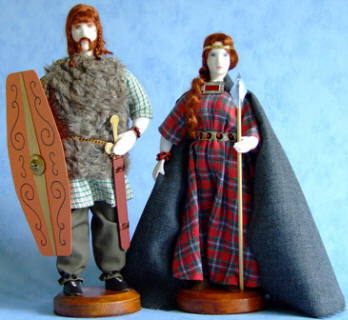
The Chieftainess wears a plaid tunic and woollen cloak.
The male Briton of Rank wears fur for warmth and braies (trousers) beneath his tunic.
Both are armed to the teeth because when they weren't fighting off Romans, they were busy fighting amongst themselves.

The Lady wears a layered ensemble. The shorter over-tunic has wide sleeves and fine embroidered borders.
The Nobleman also has embroidery on his short tunic and a cloak over one shoulder.
Anglo Saxon women were famous for their skill at embroidery.

The Lady has sleeves so wide they sometimes had to be knotted up out of the way to save her falling over them and her long plaits of hair could be partly false. So you see, 'Extensions' are nothing new.
The Gentleman has adopted the layered look previously worn by ladies.

The Lady wears silk for the first time in Britain - brought back home by the crusading knights. Her headdress is the start of many fantastic styles seen throughout the middle ages.
The Gentleman has a tunic that is split at front and back to allow him to get on his horse.